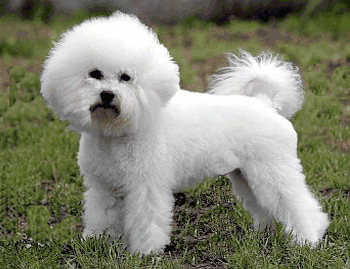The Life of Animals | Bichon Frisé | The Bichon Frise is a small dog weighs approximately That 5-10 kg (10-20 lbs) and stands 23-30 cm (9-12 in) at the withers, but slightly larger dogs are not uncommon. Coat colors are solid white, apricot or gray. Bichon Frises can have a medium-high intelligence of the American Kennel Club (AKC) refers to the Bichon Frise as "merry" and "cheerful", and the breed standard calls for a Dog That Is "gentle mannered, sensitive, playful and affectionate" . The Bichon Frise loves human company and demands much of your attention. Bichon Frise in (combined) UK and USA / Canada surveys had an average life span of about 12-13 years, with Bichon Frises in the UK tending to live longer than Bichon Frises in the USA / Canada. This breed's longevity is similar to other breeds of its size and a little longer than for purebred dogs in general.
The oldest Bichon Frises for the which there are reliable records in Various USA / Canada surveys have Died at 19 years. In a 2004 UK Kennel Club survey, the Bichon Frise Leading Causes of death were old age (23.5%) and cancer (21%). AIHA and ITP were Responsible for the greatest amount of Bichon Frise "lost years." While cancer is a more common cause of death than AIHA / ITP, Bichon Frises That Died Died of cancer at a median age of 12.5 years. Hematologic Deaths Occurred at a median age of only 5 years. Bichon Frises in the UK survey had a lower rate of hematologic Deaths (3%) than in the USA / Canada survey (11%). Bichons are also prone to liver shunts.
When detected early, can be corrected Often shunt through surgery. Shunts can be kept under control through special diets of low protein and through Various medications to support liver function, help flush out toxins build up in That the kidneys and liver, and control seizures That Often occur as a symptom of the shunt. Without surgery, Bichons with shunts on average live to be 4-6 years old. If you own a smaller than average size bichon please consult your vet. Other symptoms include dark urine, lethargy, loss of appetite, increase of in drinking. Shunts are a serious condition of smaller breeds, and Often not associated with Bichons.
Because autoimmune hemolytic anemia (AIHA, also called immune-mediated hemolytic anemia, or IMHA) and immune-mediated thrombocytopenia (ITP) are Responsible for premature Bichon Frise Deaths, Bichon Frise owners should be particularly alert to the symptoms of these conditions. In AIHA, the dog's immune system attacks its own red blood cells, leading to severe, life-threatening anemia. Symptoms include weakness, loss of energy, lack of appetite, vomiting, diarrhea, rapid heart rate, rapid breathing, dark urine, and pale or yellow gums.Thrombocytopenia Often accompanies AIHA. In ITP, blood platelets (which cause blood clotting) are destroyed.












